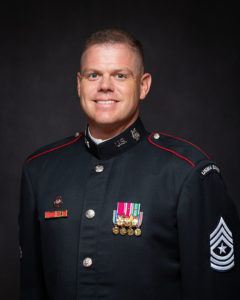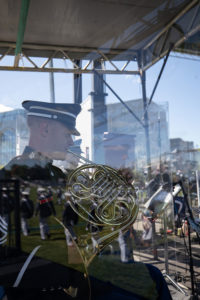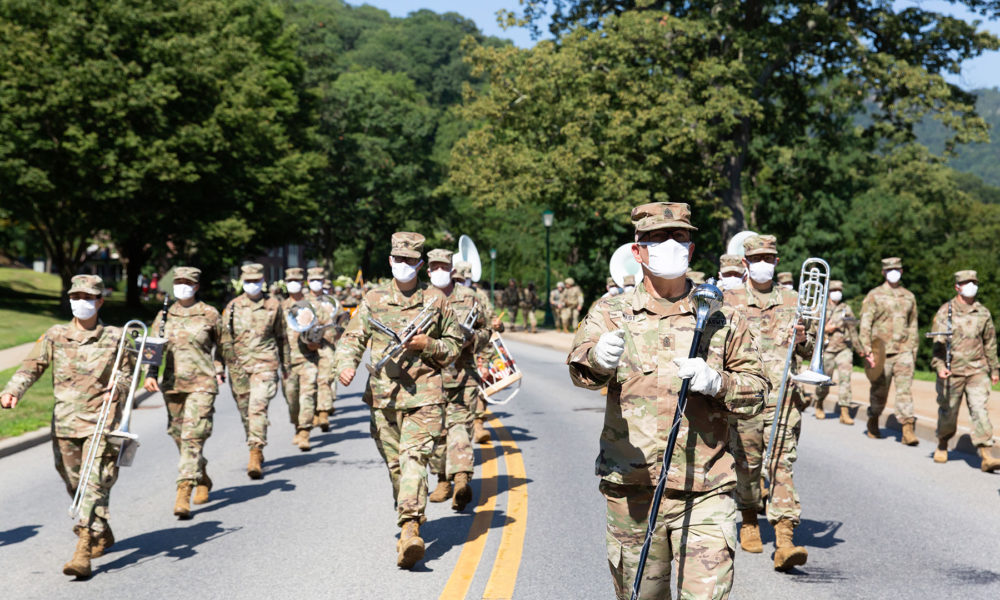With its early research and early implementation of mitigation strategies against COVID-19, the West Point Band provides an example that other ensembles can emulate in order to get back on the field and stage.
 As many schools and universities struggled with hosting live events at the end of the 2020 academic year due to the COVID-19 pandemic, ensembles at the U.S. Military Academy (USMA) West Point forged ahead. The West Point Music Research Center had acted quickly to study the problem and decided on mitigation strategies, such as clear plexiglass barriers between musicians, that would allow ensembles to continue practicing and performing. On June 13, West Point held a graduation ceremony with live music played by the West Point Band.
As many schools and universities struggled with hosting live events at the end of the 2020 academic year due to the COVID-19 pandemic, ensembles at the U.S. Military Academy (USMA) West Point forged ahead. The West Point Music Research Center had acted quickly to study the problem and decided on mitigation strategies, such as clear plexiglass barriers between musicians, that would allow ensembles to continue practicing and performing. On June 13, West Point held a graduation ceremony with live music played by the West Point Band.
The study being conducted by the West Point Music Research Center, in partnership with the USMA Photonics Research Center, will continue to investigate airflow and particle concentrations from music activities to aid all band ensembles in having a safe return to classrooms and stages.
The West Point Band comprises several groups, including a concert band, marching band, the Hellcats field band, brass quintet, and a pop ensemble.
Sergeant Major Denver Dill, a researcher at the West Point Music Research Center, shares information about the decision-making processes as well as the safety protocols that ensembles are implementing.
Halftime: How did you become involved with the West Point Band?
Dill: I’ve been at the West Point Band for 17 years. I was hired as a trumpet player, and since then, my duties have changed and been shaped, so that I’m the army music analytics team leader, and I work in the West Point Music Research Center. … In developing our leaders of character here at West Point, as part of the holistic leadership development model, a lot of time and thought and research have gone into how music is a part of their development, so that they’ll be effective officers and good leaders … when they graduate. So, I’ll be speaking from both perspectives, as a Music Research Center [member] and as a band member.
Halftime: The West Point Band was one of the first ensembles in the country to restart live performances. What types of performances have occurred?
Dill: As a West Point Band member, we have had to adapt some of what we do, but a lot of what we do has not stopped. … Ceremonies have been happening, [such as] active-duty services. We’ve had changes of command. … Lots of anthems and other patriotic music [go] along with those ceremonies. But we have a very effective kind of playbook in place where we are socially distant, we take non-pharmaceutical interventions, we take it very seriously.
Halftime: What research methods and decision-making processes did the West Point Band employ to quickly address the challenges brought on by COVID-19?
 Dill: We’re a very disciplined unit. I work with amazing intelligent professionals. … We have a sense of pride in service, so that we would do whatever is needed to be done. … It’s an important … distinction that we make [between] the service academies versus traditional colleges or conservatories.
Dill: We’re a very disciplined unit. I work with amazing intelligent professionals. … We have a sense of pride in service, so that we would do whatever is needed to be done. … It’s an important … distinction that we make [between] the service academies versus traditional colleges or conservatories.
We have really great minds here that are prepared for this type of pandemic. Our superintendent had experience in his previous command in Africa dealing with … Ebola. … And there are … military decision-making processes … to execute what needs to be done.
[The West Point Music Research Center is working] with West Point’s Photonics Research Center. We’re conducting [an aerosol] study very similar to the ones you might have seen out in Colorado or early on with Vienna Philharmonic. We’re doing [our research] in real-world environments as opposed to just controlled spaces. So, think rehearsal halls or outdoors. Those are the areas where we’re going to be focused on because that’s where most high school bands are. That’s where junior high bands are. That’s where the winter [ensembles] are going to rehearse, so we’re trying to provide very usable research to everybody. And we’re right outside of New York, so this [study] would [help] Broadway or the New York Philharmonic, or all these other entities.
Halftime: Why did you choose to make your research so easily adaptable for various ensembles, such as high school and junior high bands?
Dill: We have a soft spot in our hearts, especially for [music] programs that are maybe not well-funded throughout the country … [to] help them in a way that they couldn’t help themselves. We would really like to be able to help those band directors, help those orchestra directors, or [help] those choir directors to have very good authoritative information to add to a larger body of knowledge.
Halftime: What specific safety procedures have West Point field groups, such as the marching band and Hellcats, adopted?
Dill: [On Aug. 10], the new cadet candidates had their final culminating event, a 12-mile march. [In the past,] we would bring in all of the old graduates. They would be invited back to march with [new candidates] to remember that experience from the time they were cadets. This time [alums] joined us virtually. But the [marching] band did lead [candidates] through their final March Back [to campus from basic training]. … We had masks, and we had a little bit wider space in our formations.
Our Hellcats have been out doing training. These new cadets are learning sword technique [sabers], and they’re learning how to march and how to do “pass in reviews” and troop movement, all these things that are very core to the U.S. Army. … They look a little different because it wasn’t socially normal for people to be wearing masks in our country. But I think everybody started to understand that and come to grips with it. So now it’s just taken for granted if you’re going to be out there. You’re doing the right thing, and you’re wearing a mask, and you get it done.
Halftime: What advice or encouragement can you give to band directors as they continue to adapt their ensemble practices and performances for the remainder of the pandemic?
Dill: Music is part of who we are. It’s part of what makes us human. … Live shared experiences [are] still a component of humanity, and we will always thirst for that. …
Everybody’s trying to fight that thirst, that need, with not wanting to be unsafe. And I’m in that same space as everybody else, but I’m privileged to be surrounded by the professionals that I work with [to allow ensembles to continue].


